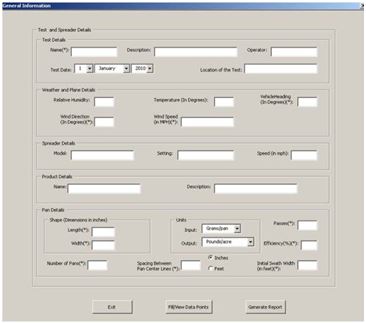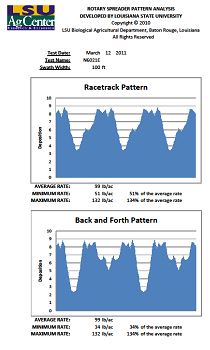 |
June 2013
|
June 2013 // Volume 51 // Number 3 // Tools of the Trade // v51-3tt10
SpreaderCal: An MS Excel-Based Computer Program for Spreader Calibration
Abstract
A Microsoft Excel-based software was developed to help Extension professionals with spreader calibration. Small, turf-used ground spreaders as well as spinner-type spreaders used in row crop agriculture can be calibrated using this software. Spreaders used in aerial application of urea and seed rice can also be calibrated. The software calculates the most commonly sought information during a calibration such as: total swath, optimized swath according to coefficient of variation (CV), and application rate.
Introduction
Spreader calibration is an essential task that should be performed frequently. Nitrogen rich fertilizers such as urea (46% nitrogen) when applied to turf lawns and agricultural crops with un-calibrated spreaders often leaves very distinct and alternating marks of dark and light green, an undesirable effect of poor spreader calibration (Scharf, 2009). Poor fertilizer distribution may lead to yield variations. Farmers and homeowners alike are usually upset with streaks throughout the field. Golf course managers who strive for maximum vision aesthetics of their fields are particularly sensitive to nitrogen streaks.
To calibrate both ground and aerial-based spreaders a set of pans is generally used. Pans are linearly arranged perpendicularly to the wind direction, and the spreader is then passed through the pans. Product collected in each pan is weighed and graphed according to pan position. The American Society of Agricultural and Biological Engineers (ASABE) has published standards on spreader calibration procedures (ASAE S386.2 and ASAE S341.4).
The calculation of application rate (AR) in pounds per acre and effective swath width (ESW) in feet is difficult and time consuming, even if the user is knowledgeable about spreadsheet operations. Spreadsheet programs like Microsoft Excel are currently used to aid calibration of sprayers (Patterson, 2011). To determine both AR and ESW, multiple passes have to be overlapped at the desired swath. The mode of operation (back-and-forth or racetrack) has to be observed.
Entering Information on SpreaderCal
A "general information" dialog box appear upon starting SpreaderCal. This is the main window where the user performing the calibration will enter all pertaining information such as: test name, description of the test, weather information, spreader and product details, and pan information. Generally during a calibration, wind speed, wind direction, and vehicle heading are recorded using a wind meter and compass. More advance meters have a built-in compass and can accurately measure all variables at the same time. If this information is available, the software will calculate a crosswind component. This is vital information because the presence of crosswinds during calibration may alter product distribution. The user should also inform width and length of the pans used as well as the number of pans and spacing between pans. This information is used to calculate ESW and AR. Figure 1 shows a screenshot of the general information window.
Figure 1.
The General Information Window of SpreaderCal

Upon entering all basic information, the user is prompted to enter the weight collected in each pan and to generate a report. A four-page report is displayed. Page number one contains all information on the test being performed. Page number two graphs the spreader pattern and calculates amount of product placed to the right and left of the spreader as well as the total swath in feet and crosswind information. Page number three graphs overlapped passes at the specified swath, in both racetrack and back-and-forth modes, and calculates the average, minimum and maximum rates in pounds per acre. Page number four displays a table of varying effective swath widths and their corresponding coefficient of variations (CV). The user can then select what is the appropriate swath width to recommend according to CV. Figure 2 shows a sample of page number 3 of a report.
Figure 2.
Sample Output of the SpreaderCal Program

Conclusion
SpreaderCal can help Extension professionals calibrate ground-based and aerial-base spreaders. Spreader calibration is essential activity for product optimal performance and fertilizer distribution uniformity. Extension professionals interested in this program should send an email request to rbarbosa@agcenter.lsu.edu.
References
American Society of Agricultural Engineers. (1995). ASAE standards engineering practices data. 42nd Edition. ASABE. St. Joseph, MI.
Patterson, R. K. (2011). Boom sprayer calibration made easy with an Excel spreadsheet program. Journal of Extension [On-line], 49(1) Article 1TOT7. Available at: http://www.joe.org/joe/2011february/tt7.php
Scharf, P. (2009). Streaky fields and uneven application of N fertilizer. Nutrient News in Missouri, 19(2), 10-11. Retrieved from: http://plantsci.missouri.edu/nutrientmanagement/news.htm



